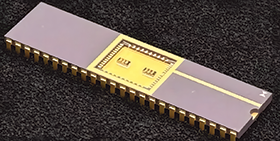

TDK Corporation announced the development of a neuromorphic element called a ‘spin-memristor’ that has very low power consumption.
By mimicking the energy-efficient operation of the human brain, this element could cut the power consumption of AI applications down to 1/100th of traditional devices. Collaborating with the French research organisation CEA (Alternative Energies and Atomic Energy Commission), TDK has proven that its ‘spin-memristor’ can serve as the basic element of a neuromorphic device. Going forward, TDK will collaborate with the Centre for Innovative Integrated Electronic Systems at Tohoku University on the practical development of the technology.
In recent years, digital transformation has advanced due to the development of AI; it is predicted that energy consumption utilising big data and AI will boom and make certain issues more apparent, such as the complexity around the computational processing of vast amounts of data, and the increased power consumption associated with the development of AI. TDK is striving to contribute to solving these social and environmental issues.
The human brain requires around 20 W of power, which enables it to make more complex decisions than current digital AI processors, but with far lower power consumption. Therefore, TDK set itself a goal to develop a device that electrically simulates the synapses of the human brain: the memristor. While conventional memory elements store data in the form of either 0 or 1, a ‘spin-memristor’ can store data in analogue form, just as the brain does. This makes it possible to perform complex computations with ultra-low power consumption. Although memristors for neuromorphic devices already exist, they face issues such as changes in resistance over time, difficulties in controlling the precise writing of data, and the need for control to ensure that data is retained. TDK’s solution solves these issues and is expected to offer immunity to environmental influences and long-term data storage, while reducing power consumption by cutting leakage current in existing devices.
To achieve this, TDK started collaborating with the CEA in 2020. With this support, an AI circuit equipped with a ‘spin-memristor’ (three elements × two sets × four chips) was developed, and its successful operation through a sound separation demonstration was confirmed, proving that ‘spin-memristors’ can serve as basic elements in AI circuits. In the demonstration, even when three types of sound (music, speech, and noise) were mixed with arbitrary ratios, the circuit was able to learn and separate the three types of sound in real-time. In general machine learning, AI operations are performed based on data that the AI model has previously been trained on, but TDK’s device is uniquely capable of learning in a changing environment in real-time.
Now that it has been confirmed that the ‘spin-memristor’ can serve as the basic element of a neuromorphic device, TDK will advance this project from basic development to the next stage which is practical application. The manufacturing of these products requires the integration of semiconductor and spintronic manufacturing processes. This integration has been achieved in the manufacturing of MRAM, a product similar to memristors, and TDK has decided to pursue integrated technological development on a joint basis with Tohoku University, a leading academic institution in MRAM research and development.
For more information visit www.tdk.com
© Technews Publishing (Pty) Ltd | All Rights Reserved